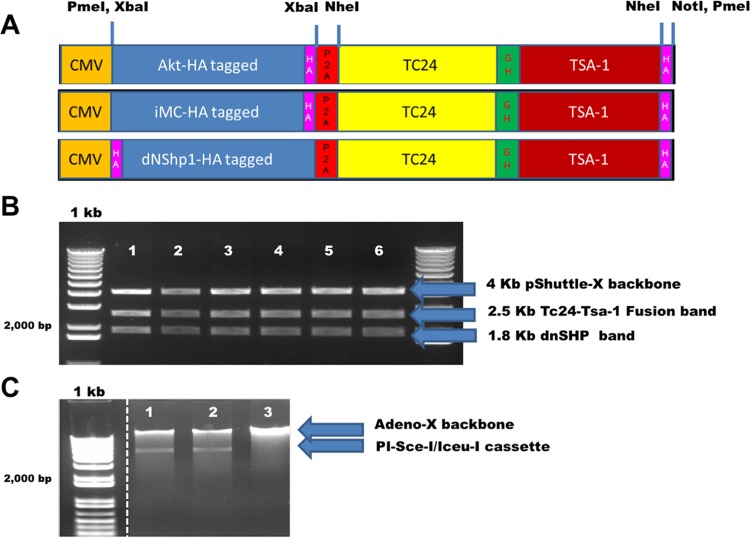FIG 1.
Bicistronic adenoviral constructs encoding functional adjuvants and parasite-specific antigens. Replication-deficient human recombinant adenovirus type 5 vectors were constructed with the genetic adjuvants caAKT (constitutively activated Akt), iMC (inducible MyD88/CD40), or dnSHP (dominant negative SHP-1) upstream of the T. cruzi antigens Tc24 and TSA1. (A) HA-tagged genetic adjuvants (Akt, iMC, and dnSHP) were cloned into the XbaI site of the pShuttle plasmid driven by the cytomegalovirus (CMV) promoter. The T. cruzi antigens Tc24 and TSA1 were cloned as a fusion fragment downstream of the adjuvants between the NheI and NotI sites. A single glycine hexamer linker separated the antigens, while a P2A sequence inserted between the antigens and adjuvant permitted the cleavage of the two. The expression cassette was cloned into the PmeI site of the pShuttle plasmid. (B) Restriction digestion of ampicillin-resistant positive shuttle plasmid clones with PmeI and XbaI generated the shuttle backbone fragment (4 kb), a fragment corresponding to the adjuvant (1.8 kb), and a fusion fragment corresponding to the antigens (2.5 kb). The clones were later confirmed by direct sequencing. (C) Psce-I and Iceu-I digestion of the shuttle plasmid released the construct, which was then ligated into the adenoviral backbone according to the manufacturer's instructions. Ampicillin-resistant clones were selected, and further confirmation of the positive clones was performed by means of Psce-I and Iceu-I restriction digestion followed by direct sequencing. The standard 1-kb ladder indicates the DNA fragment size with a doublet at 2.0 and 1.65 kb. The dotted line between the 1-kb ladder and shuttle plasmid digestions indicates the absence of irrelevant, unrelated digestion lanes spliced out of the image.

